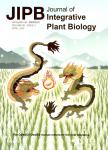Disease Resistance in Maize and the Role of Molecular Breeding in Defending Against Global Threat
Disease Resistance in Maize and the Role of Molecular Breeding in Defending Against Global Threat作者机构:National Key Laboratory of Crop Genetic Improvement Huazhong Agricultural University Wuhan 430070 China Cereal Crop Research Institute (CCRI) Pirsabak Nowshehra Pakistan
出 版 物:《Journal of Integrative Plant Biology》 (植物学报(英文版))
年 卷 期:2012年第54卷第3期
页 面:134-151页
核心收录:
学科分类:0710[理学-生物学] 090403[农学-农药学(可授农学、理学学位)] 09[农学] 0904[农学-植物保护] 0901[农学-作物学] 0703[理学-化学] 0902[农学-园艺学]
基 金:supported by the National Natural Science Foundation of China (31161140347)
主 题:Maize concept of pathology R-genes types of resistance genetic diversity genome wide association study.
摘 要:Diseases are a potential threat to global food security but plants have evolved an extensive array of methodologies to cope with the invading pathogens. Non-host resistance and quantitative re- sistance are broad spectrum forms of resistance, and all kinds of resistances are controlled by extremely diverse genes called "R- genes". R-genes follow different mechanisms to defend plants and PAMP-induced defenses in susceptible host plants are referred to as basal resistance. Genetic and phenotypic diversity are vital in maize (Zea mays L.); as such, genome wide association study (GWAS) along with certain other methodologies can explore the maximum means of genetic diversity. Exploring the complete genetic archi- tecture to manipulate maize genetically reduces the losses from hazardous diseases. Genomic studies can reveal the interaction be- tween different genes and their pathways. By confirming the specific role of these genes and protein-protein interaction (proteomics) via advanced molecular and bioinformatics tools, we can shed a light on the most complicated and abstruse phenomena of resistance.



